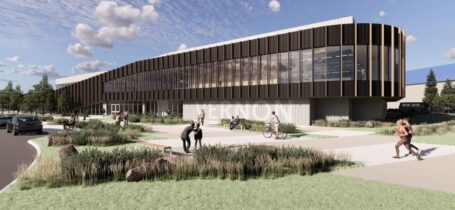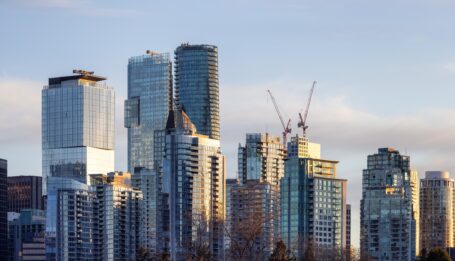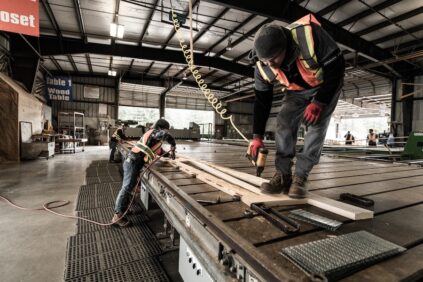

Private developers command the spotlight in B.C., but two of our top real estate players are a publicly traded owner of U.S. hotels—and a government agency tackling the province’s housing crisis
Sooner or later, anyone with designs on the U.S. hotel market will get to know a small Vancouver firm called American Hotel Income Properties REIT LP (AHIP). Last year AHIP was the No. 3 buyer of stateside hotels after U.S. investment giants Starwood Capital Group and Blackstone Group, purchasing $750 million worth of properties, says president Ian McAuley.
“Now we get the phone calls from the big investors that maybe want to sell a portfolio and don’t want to go through a marketing process,” McAuley adds of AHIP, a new addition to the Top 100 at No. 90. “We’re a well-known entity now where three years ago nobody had even heard of us.”
AHIP, which has 15 employees, was co-founded by CEO Rob O’Neill and launched in 2013 by going public on the Toronto Stock Exchange. The limited partnership owns one asset, a U.S.-based hotel/lodging REIT.
“It’s an opportunity for Canadian investors to invest in hotel real estate in the U.S.,” McAuley says of AHIP. “There was no vehicle for a Canadian to do that until we created this company.”
AHIP focuses on premium branded hotels—names like Hilton, InterContinental and Marriott—in secondary markets such as Cincinnati, Ohio; Allentown, Pennsylvania; and Jacksonville, Florida. “We own the building and operate the business through a third-party manager,” McAuley says.
Two decades ago, O’Neill and his brother, John O’Neill, started the Canadian Hotel Income Properties Real Estate Investment Trust (CHIP REIT). But launching a REIT in Canada has been forbidden since federal income trust laws changed in 2007, the same year British Columbia Investment Management Corp. bought CHIP REIT for $1.2 billion.
As of May, AHIP owned 115 hotels in 33 states and had an enterprise value of $1.6 billion. Where Canada offers only six markets with more than 1 million people, the U.S. is home to hundreds, McAuley notes. Its secondary markets contain 3.4 million guest rooms, versus just 1.6 million in primary centres like New York and Los Angeles.
AHIP looks for so-called select service hotels—a simple, efficient business model with limited amenities—patronized by business travellers. “We are focused on that road warrior from Monday through Thursday,” McAuley says.
AHIP, which distributes income monthly in U.S. dollars, was delivering a yield of some 10 percent in May. “About 90 percent of the income we receive gets distributed back to the investors,” McAuley explains. AHIP closed at $8.46 per unit on May 31, down 9 percent for the year.
The business isn’t exposed to Airbnb, McAuley says, because that service is concentrated in the top 25 markets and centred around major events: “We aren’t owntown located; we aren’t leisure-driven; we aren’t event-driven.”
McAuley sees plenty of upside for AHIP. Since the Great Recession, the American lodging industry has expanded every month, with room demand outpacing abundant new supply, he says. The U.S. Federal Reserve Board and other economic forecasters are calling for gross domestic product to grow at least 2.5 percent this year.
Still, AHIP takes a long-term, conservative approach, McAuley says. For example, the firm’s capital structure ensures that its debt on properties is low compared to their value. “We’re not buying hotels that we’re going to pick up and renovate and flip in two years,” he says. “Over the long run, they’re a good, solid investment.”
House plans
The BC Housing Management Commission provides a different kind of shelter—homes for British Columbians from a variety of income brackets. “BC Housing is not on a lot of people’s radar screens, but we really are one of the largest developers in the province,” says CEO Shayne Ramsay.
The Crown corporation jumped from No. 67 to No. 36 on our list, thanks to new funding from the provincial government that will push revenue to a projected $1.28 billion in 2018-19. In its service plan for that year, the target is about 3,500 new housing units, Ramsay notes.
“Very few developers—I would risk to say probably none—develop as many units as the province and BC Housing do on an annual basis,” he says. “There are more housing units under development and construction in British Columbia in the affordable/social housing field than in the rest of the country combined.”
BC Housing expects that in 2018-19 it will help more than 111,600 households. Over the next decade, the province is investing almost $7.7 billion in housing, a move that will directly fund some 28,700 new units, Ramsay says. About $1.1 billion of that total will go toward renovating B.C.’s 60,000 existing non-profit and social housing units, he adds.
In its February budget, the provincial government launched HousingHub, a BC Housing division that will work with everyone from private developers and non-profits to Indigenous organizations and faith-based groups to build affordable market rental and owner-purchased housing.
“The HousingHub units will be seeking out those partnerships and target households that earn between $50,000 and $100,000,” Ramsay says. “What we’ll bring to those kinds of partnerships are things like access to land, low-cost project development financing, and work with them to identify other sources of financing as well, particularly now that the federal government is back in the business.”
For its first project, HousingHub teamed up with the B.C. Conference of the United Church of Canada to develop roughly 400 affordable rental units on four sites in Coquitlam, Nanaimo, Richmond and Vancouver. The church will establish a non-profit to manage the properties, but all four will share resources and revenue, Ramsay says. “By taking that portfolio approach, you’re able to develop in locations where typically without subsidy, you couldn’t build affordable rental housing.”
How far will BC Housing’s efforts go toward solving the housing affordability crisis? About 1,500 of its planned 28,700 units are for women and children leaving violent relationships, 750 for Indigenous people and another 4,500 for the homeless, Ramsay says. All of them come with long-term subsidies that didn’t previously exist, so the province can provide round-the-clock support to help stabilize lives before people move to permanent affordable housing, he explains.
BC Housing faces challenges, though: finding the capacity to build all of its planned housing, and reassuring communities hostile to its efforts.
“We seem to be able to get access to the construction services we need, but it is getting more and more difficult,” Ramsay admits. Rising construction prices aren’t helping. “One of the other components of the 2018 budget was an additional $75 million for projects in the pipeline to deal with some of those affordability issues and make sure we can still hit those affordability targets,” Ramsay says.
Meanwhile, not all municipalities have been receptive—witness recent protests in Maple Ridge against the corporation’s proposed homeless housing there.
“The message that we’ve been delivering is that these are people in your community,” Ramsay says. Residents of such projects won’t come from elsewhere, he points out, and they will be properly assessed and have 24/7 support. “Simply bringing them inside, isn’t that a much better opportunity to make some different choices than if you’re still in a doorway or living by the bank of a river?” ?





